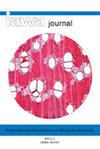Comparative wood anatomy of 16 Malagasy Dalbergia species (Fabaceae) using multivariate techniques
IF 1.4
3区 农林科学
Q2 FORESTRY
引用次数: 0
Abstract
Rosewood and palisander (Dalbergia L.f., Fabaceae) are sources of highly valuable tropical timber and include species threatened by habitat degradation and selective logging for national and international trade. Law enforcement depends on reliable and cost-effective species-level identification of timber along the supply chain. The potential of wood anatomy to distinguish between species has not yet been systematically investigated for Dalbergia species from Madagascar. We assessed 36 qualitative and eight quantitative wood anatomical features in 16 Malagasy Dalbergia species that form medium-sized to large trees, representing each species by at least five individuals. We integrated and contrasted the newly collected data with existing data from InsideWood and two previous studies. Principal component analysis of 93 individuals and 29 variables resulted in non-overlapping hulls for eight species with respect to the first two dimensions. Four quantitative features (number of ray tiers per millimetre, number of rays per millimetre, vessel density, and vessel element length) and two qualitative features (scanty paratracheal axial parenchyma and irregular to absent storied structure) were found to be potentially diagnostic to distinguish three single species and three pairs of closely related species. Following our analyses, we provide a provisional microscopic wood anatomical identification key for the 16 Dalbergia species, which can be applied to both logs and sawn wood.应用多元技术对16种马达加斯加降香属植物的木材解剖比较
红木和红木(Dalbergia L.f, Fabaceae)是高价值热带木材的来源,包括受到栖息地退化和国内和国际贸易选择性砍伐威胁的物种。执法取决于对供应链上的木材进行可靠和具有成本效益的物种级鉴定。木材解剖学对马达加斯加黄檀树种区分的潜力尚未进行系统的研究。我们评估了16个马达加斯加黄檀树种的36个定性和8个定量木材解剖特征,这些树种形成中型到大型树木,每个物种至少有5个个体。我们将新收集的数据与InsideWood的现有数据以及之前的两项研究进行了整合和对比。对93个个体和29个变量的主成分分析结果表明,8个物种在前两个维度上不重叠。四个定量特征(每毫米射线层数、每毫米射线数、血管密度和血管单元长度)和两个定性特征(气管旁轴向薄壁稀疏和不规则或缺失层状结构)被发现是区分三个单一物种和三对密切相关物种的潜在诊断特征。根据我们的分析,我们提供了16种黄檀属植物的临时显微木材解剖识别密钥,该密钥可用于原木和锯材。
本文章由计算机程序翻译,如有差异,请以英文原文为准。
求助全文
约1分钟内获得全文
求助全文
来源期刊

IAWA Journal
农林科学-林学
CiteScore
3.40
自引率
15.80%
发文量
26
审稿时长
>36 weeks
期刊介绍:
The IAWA Journal is the only international periodical fully devoted to structure, function, identification and utilisation of wood and bark in trees, shrubs, lianas, palms, bamboo and herbs. Many papers are of a multidisciplinary nature, linking
 求助内容:
求助内容: 应助结果提醒方式:
应助结果提醒方式:


